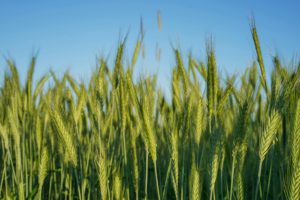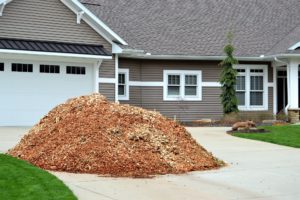Determining how often should you mow you lawn can be a surprisingly trick task, as the growth rate of grass isn’t static throughout the season. The University of California Agriculture & Resources studied grasses commonly used in North American lawns. They found that warm-season grasses grow best in southern climates, as they thrive in the heat of summer and mild winters. While cool-season grasses are best for northern climates where summers are mild and winters are cold. Growth rates for both types of grasses change season by season, therefore it’s important to determine the optimal mowing frequency throughout the season.
Understanding Grass Growth Patterns
Grass growth rates fluctuate significantly throughout the growing season and vary between northern and southern climates due to a combination of factors such as temperatures, sunlight, and precipitation. In northern regions, grasses typically thrive in the spring and fall due to the cooler, wetter weather but growth slows in the summer. Conversely, in southern climates, warm-season grasses thrive in the heat of summer, growing steadily through the season but slower during the cooler winter months. These fluctuations are influence not only by seasonal changes but also by soil quality, humidity, and local weather patterns, making it clear that grass growth is far from constant and requires tailored care throughout the year.
The Influence of Climate on Growth
Climate differences play a pivotal role in lawn growth and how often mow your lawn, with distinct variations between northern cooler climates and southern warmer climates. In northern regions, cooler temperatures and a shorter growing season favors cool-season grasses such as Kentucky bluegrass and fescue. These grasses thrive in the moderate temperatures of spring and fall but can struggle during the hot summer months.
In contrast, southern climates, characterized by longer growing seasons and higher temperatures, are more suitable for warm-season grasses like Bermuda grass and Zoysia. These grasses flourish in the heat and maintain vigorous growth throughout the summer, but their growth slows considerably or stops entirely during the cooler winter months.
The Role of Seasonal Changes
Seasonal changes have a profound impact on grass growth, creating distinct periods of rapid growth and slowdowns throughout the year that impact how often to mow lawn. In the early season, as temperatures begin to rise and the days lengthen, grasses experience a growth spike driven by increases sunlight and spring rain. This is a critical time for lawn care, as grass needs frequent mowing to maintain optimal health and appearance.
As the season progresses into mid-summer, the combination of high temperatures and often reduced rainfall can cause a noticeable slowdown in growth. During this period, grass may enter a semi-dormant state to conserve water and energy. Finally, as the summer heat wanes and fall brings cooler temperatures and more consistent rainfall, grasses typically undergo a second growth spurt, preparing for winter dormancy.

Mowing Recommendations for Northern Cooler Climates
For lawns in cooler northern states, mowing guidelines should be tailored to the distinct growth periods observed throughout the year. Based on research from the University of California Agriculture & Natural Resources, peak growth typically occurs in the early spring and fall when temperatures are moderate and rainfall is abundant. During these periods, cool-season grasses can grow rapidly, increasing how often should you mow your lawn to as often as once a week. Your lawn should be kept at a height of around 2.5 to 3 inches.
In the summer, as growth slows due to higher temperatures and potential drought conditions, mowing frequency can be reduced to every 10-14 days. During this time, it’s important to avoid cutting the grass too short, as this can stress the lawn and increase its vulnerability to heat and pests.
Managing Early and Late Season Spikes
During the early and late season growth spikes, weekly mowing becomes essential to prevent overgrowth and maintain the appearance of the lawn. These periods, marked by optimal temperatures and sufficient rainfall, stimulate rapid grass growth, causing lawns to quickly become overgrown if not regularly cut. Weekly mowing ensures that the grass remains at an ideal height, which not only keeps the lawn looking neat but also promotes healthier grass. Regular mowing prevents the grass becoming too long and dense, which can lead to issues such as thatch buildup, increased vulnerability to pests, and reduced sunlight penetration to the lower blades.
Adapting to Midsummer Slowdowns
During the peak heat of midsummer, how often to mow lawn decreases significantly to either a bi-weekly or monthly schedule. The intense heat and drier conditions significantly slow down grass growth, causing cool-season grasses to enter a semi-dormant state. By reducing mowing frequency, homeowners can minimize stress on the lawn. Allowing the grass to grow slightly latter also helps shade the soil, reducing evaporation and retaining moisture, which is critical during hot, dry periods.
State-Specific Mowing Schedules
For homeowners in northern states like Michigan, Illinois, Minnesota, and Ohio, understanding and adapting your mowing practices to the typical growth patterns of cool-season grasses is key to maintaining a healthy lawn. In these regions, grass growth peaks during the cooler spring and fall months, spurred by moderate temperatures and ample rainfall. During these times, it’s crucial to mow the lawn weekly to manage the rapid growth and keep the grass between 2.5 to 3 inches.
As summer arrives, the growth rate slows significantly due to higher temperatures and potential drought conditions, allowing for a reduced mowing frequency of every 10-14 days. To ensure the lawn remains resilient during the hot months, avoid cutting the grass too short, which can stress the lawn and expose the soil to excessive sunlight.
Mowing Recommendations For Southern Warmer Climates
For homeowners in warmer southern states, mowing guidelines should align with the unique growth patterns of warm-season grasses. These grasses thrive in the heat and grow rapidly during the long, hot summer months. During this peak growth period, frequent mowing every 7 to 10 days is essential to keep the grass at an optimal height of 1.5 to 2.5 inches. This regular mowing helps maintain a dense and healthy turf, preventing thatch buildup and promoting strong root systems. In the cooler months, growth slows significantly or even ceases, allowing for less frequent mowing or a break from mowing.

Peak Summer Mowing Needs
In warmer southern states, warm-season grasses like Bermuda grass, Zoysia, and St. Augustine experience a single, pronounced growth spike that aligns with the summer peaks. During this period of intense heat and extended daylight, these grasses grow rapidly and require consistent weekly mowing to maintain optimal health and appearance. Regular weekly mowing and keeping the grass at an ideal height of 1.5 to 2.5, prevents the lawn from becoming overgrown and helps maintain a dense, even turf. Consistent mowing during this growth spike also encourages the development of strong roots, enhances resistance to pests and diseases, and reduces thatch buildup.
Adjusting For Off-Peak Seasons
Outside of peak growing season during the cooler months, how often should you mow your lawn decreases slightly. Switching to bi-weekly mowing can be an effective strategy to save on maintenance costs while still keeping the lawn in good condition. During these times, the reduced growth rate means the grass doesn’t need to be cut as frequently to prevent overgrowth. A bi-weekly schedule allows adequate time between mows for the grass to recover and minimizes the risk of stressing the lawn, particularly during periods of slow growth.
Handling Winter Dormancy
In southern regions, warm-season grasses naturally enter a dormant state during the winter months, as temperatures drop and daylight decreases. When temperatures consistently fall below 55°F, grass growth slows considerably, and the lawn typically requires minimal maintenance. However, if temperatures remain unusually warm, staying above 55°F, some grasses may continue to grow at a slower rate, necessitating more frequent mowing. Adjusting how often to mow lawn based on the actual temperatures helps ensure the lawn remains in good condition while avoiding unnecessary stress on the grass during its dormant phase.

Flexible Lawn Mowing Services with LawnGuru
LawnGuru offers flexible lawn mowing services, designed to cater to the unique needs of your lawn throughout the year. Understanding that grass growth rates fluctuate with seasonal changes, our services allow you adjust mowing frequency accordingly. Whether your lawn requires weekly trims during peak growth periods in spring and summer or less frequent maintenance during the winter, LawnGuru provides the right care at the right time. Get an instant price with LawnGuru and ensure your lawn remains healthy, vibrant, and well-maintained with a company you can trust.
Customizable Mowing Schedules
LawnGuru offers customers the ultimate flexibility with its customizable mowing schedules, allowing customers to seamlessly switch between weekly, bi-weekly, or monthly services to fit their specific lawn conditions. Whether your lawn grows like crazy during the growing season, requiring frequent weekly cuts, or experiences slower growth during the cooler months, LawnGuru adapts to your needs. Our user-friendly platform makes it easy to adjust your mowing frequency right within the app. By providing personalized and adaptable mowing options, LawnGuru helps you maintain a healthy and attractive lawn year round.
Benefits of the SKIP Feature
LawnGuru’s SKIP feature offers significantly advantages by allowing customers to easily bypass unnecessary mowing sessions, providing both cost savings and flexibility. If your lawn’s growth has slowed due to weather conditions or seasonal changes, you can use the SKIP feature to avoid scheduling a mow when it’s not needed. By empowering customers to make real-time adjustments based on their lawn’s current needs, LawnGuru ensures that you receive tailored care, keeping your lawn in peak condition.
Trusting Professionals for Optimal Lawn Care
When it comes to maintaining a healthy and well-manicured lawn, you can rely on LawnGuru’s team of experienced professionals. LawnGuru understands the intricacies of grass growth patterns and seasonal changes, ensuring that your lawn receives the care it needs throughout the year. By entrusting us with your mowing schedule, you benefit from our flexible scheduling, easy to adjust service, and auto-pausing service at the end of the season. LawnGuru’s tailored approach helps keep your lawn in top shape while you enjoy a hassle-free experience.


Lawn Care Schedule for Cool Season Grasses
A lawn care schedule for cool-season grasses is crucial for a healthy lawn year-round, especially in states with cool season grasses, as it is important to keep the lawn looking

How Much Does Snow Removal Cost in 2024?
In 2024, the average cost of snow removal is expected to be around $125 per session, though rates can vary considerably. A typical range falls between $50 and $203, influenced

Best Michigan Native Plants
Landscaping with native plants is beneficial to your local environment as well as your wallet. Since these plants have evolved to grow naturally in your area, they are able to

How and When to Plant Winter Rye Grass
To plant winter rye grass effectively, timing is essential. For northern regions, sow seeds from late August to early October, while southern areas should aim for late September to early

The Best Gutter Guards For Your Home [2024]
The best gutter guards of 2024 feature innovative designs and durable materials that effectively reduce debris accumulation and enhance gutter functionality. Top options include LeafFilter, known for its stainless steel

How Much Does a Yard of Mulch Cost in 2024?
In 2024, how much does mulch cost can vary considerably, influenced by the type, quality, and additional services. Natural mulch can cost between $15 and $65 per cubic yard, while


